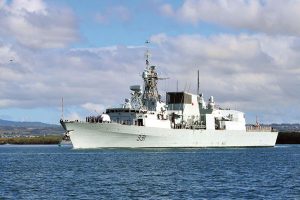RIMPAC 2016: HMCS Vancouver trains for incoming threats
By Lookout on Aug 01, 2016 with Comments 0

Royal Canadian Navy Halifax-class frigate HMCS Vancouver departs Joint Base Pearl Harbor-Hickam for Rim of the Pacific 2016. Photo by Mass Communication Specialist First Class Shannon Chambers, U.S. Navy
DND ~
Her Majesty’s Canadian Ship (HMCS) Vancouver recently joined Her Majesty’s Australian Ship (HMAS) Warramunga and United States Ship (USS) Howard for a live anti-ship missile defence (ASMD) system test in Hawaiian waters, as part of Rim of the Pacific (RIMPAC) 2016.
For Vancouver, the aim of the exercise was two-fold: to technically assess the operational effectiveness and suitability of Halifax-class ships in anti-air warfare and ASMD roles; and to tactically assess the application of knowledge and skills of the combat team in Vancouver in realistic operational ASMD. This shoot was the culmination of training reaching back to May of this year.
Lieutenant (Navy) John Claymore, Vancouver’s Above Water Warfare Officer, is responsible for the ship’s sensors division – the team of sailors responsible for surface and air warfare. This includes directing surface and air engagements using Harpoon and Evolved Sea Sparrow Missiles (ESSM), Bofor 57mm cannon, Phalanx Close-In Weapon System, MASS and RAMSES weapons systems, and the detection of ESSM/communications signals via sophisticated electronic means.
For Lt(N) Claymore, the ESSM was the final weapon he had yet to fire while employed as a Sensor Weapons Controller, an achievement accomplished by few in the Royal Canadian Navy.
“RIMPAC really is the perfect venue for us to trial and evaluate the employment of our weapons and command and control systems, and also to assess our ability to respond to threats such as anti-ship missiles,” says Lt(N) Claymore. “Ultimately, nothing can replace the experience of firing real munitions – and being successful on a live-fire exercise like this gives a huge boost in morale to the entire crew.”
Vancouver conducted a successful engagement against a combination of high altitude supersonic threats and low altitude cruise missile threats. The threats were represented by AQM-37C and BQM-74E test drones, launched from the Pacific Missile Range Facility in Hawaii, that followed predetermined flight plans towards the Surface Action Group that included HMAS Warramunga and USS Howard. The live-fire engagements of targets in both individual and mutual defence of the task unit included two ESSMs from Vancouver.
“Working together with our allies on a live range helps everyone involved fine-tune how they work with each other,” says Lt(N) Claymore. “It is crucial that we seize every opportunity to keep our team as sharp as we can – especially when it comes to defending our ship.”
This year’s RIMPAC, the 25th in the series that began in 1971, is scheduled from June 30 to Aug. 4. Twenty-six nations, 45 surface ships, five submarines, more than 200 aircraft and 25,000 personnel are participating in this year’s exercise.
Held every two years by Commander, U.S. Pacific Fleet, and executed by Commander, U.S. 3rd Fleet, RIMPAC is a multinational maritime exercise that takes place in and around the Hawaiian Islands and off the coast of southern California.
Filed Under: Top Stories
About the Author:





